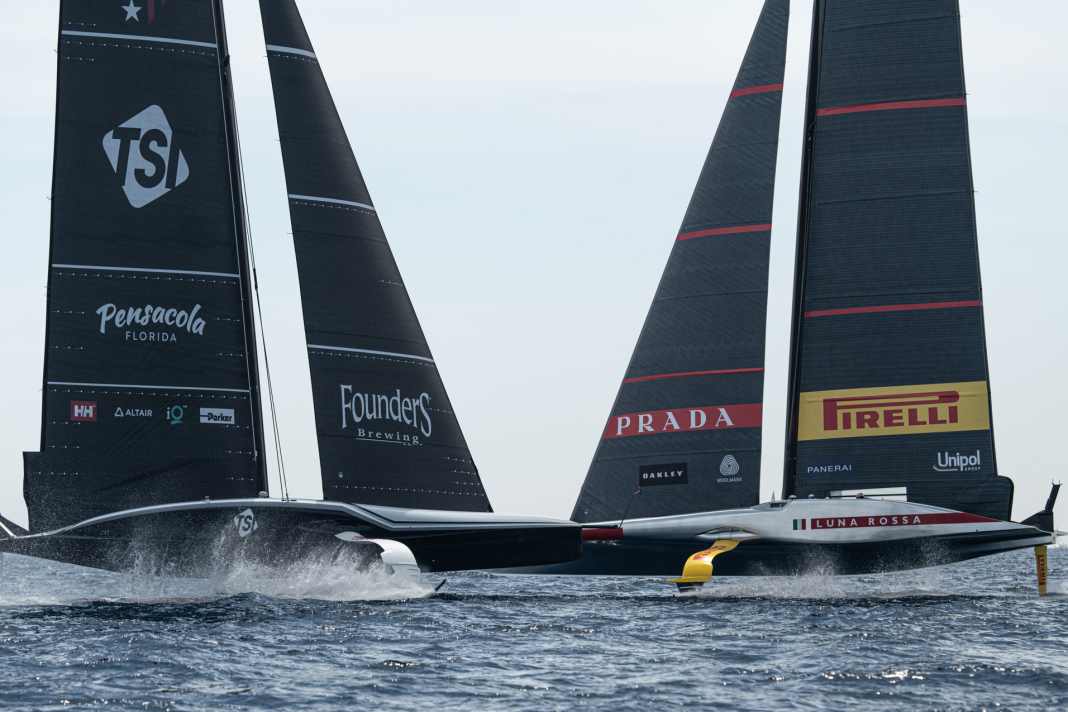





- 37th America's Cup: Foils of enormous importance
- How the regulations have changed the designs
- Bustle mould: important design decision for the America's Cup 2024
- High fashion found: Ineos Britannia's steep form curve
- American Magic: On the wrong track with the recumbent bike?
- 37th America's Cup: Can the New Zealanders still be stopped?
While the balance of power was more uncertain than at almost any previous edition in the history of the world's oldest sporting trophy, particularly in the run-up to the last pre-regatta, the round robins at the Louis Vuitton Cup have at least provided some clarity. Nevertheless, very different design approaches are still in the running for a place in the final match against the defenders from New Zealand.
Even experienced Cup experts are currently unable to identify a clear favourite. While Luna Rossa Prada Pirelli and American Magic were the favourites at the start of the elimination regatta, Ineos Britannia has also recently moved into the group of favourites. Only the Swiss team Alinghi Redbull Racing is unlikely to make it into the America's Cup match on 12 October.
37th America's Cup: Foils of enormous importance
However, the close ranking hardly seems surprising, as all teams have equally excellent sailors and are sailing in the same class as in the previous Cup. However, various factors were interpreted and weighted differently by the teams in almost all aspects of development. There is only one point where all teams are clearly more in agreement than in the previous edition before Auckland: the foil design.
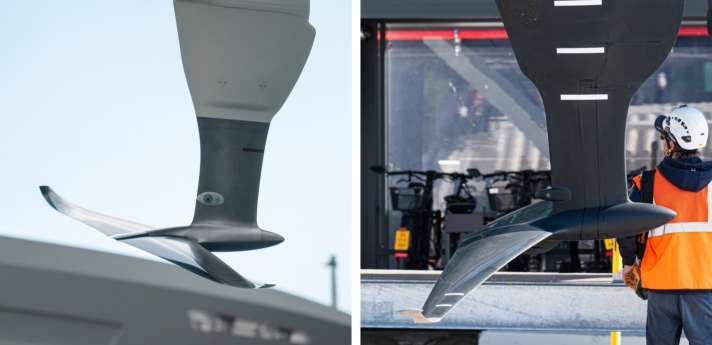
It is therefore hardly surprising that the main foils in particular are very similar to the attachments of the "Te Rehutai", which won the AC36. At the time, these were clearly different from the competition and in retrospect were identified as a key to the New Zealanders' success.
However, the knowledge gained had to be adapted to the new regulations and the area off the Catalan capital. Off Barcelona, wave heights of one metre or perhaps even more are possible. Such conditions have never been experienced in New Zealand. Even at half a metre, it is difficult to control the boats, explains foil expert and chief designer of the British team Dr Martin Fischer. "Ventilation is a big challenge. The foils must not lose all of their buoyancy as soon as they break the surface." This is why the new generation of wings is much less angled downwards and is more like a classic T-foil. This has a better angle when part of the aerofoil leaves the water.
How the regulations have changed the designs
The regulations have also led to a general improvement in foils. As a result, the current AC75s not only reach speeds of over 54 knots, but also lift out of the water much earlier. "One of the weak points in Auckland was clearly that the boats had difficulties taking off in very light winds. That's why, among other things, the span of the foils was increased to 4.50 metres." As a result, the so-called induced drag is reduced by around 20 to 25 per cent, which is a considerable gain according to Fischer.
With a crew of just eight instead of eleven gliders at the time and less ballast in the wings, the new AC75s also weigh around one tonne less. This means they are designed for long flight times in a wide range of conditions from 6.5 to 21 knots of wind speed.
We assume that Alinghi's solution is not the best." Dr Martin Fischer
In order to generate sufficient energy despite a reduced crew, the bike riders that were so revolutionary in 2017 were allowed again and the energy requirement was reduced as much as possible, especially during manoeuvres. In concrete terms, this means the legalisation of self-tacking jibs and the elimination of backstays.
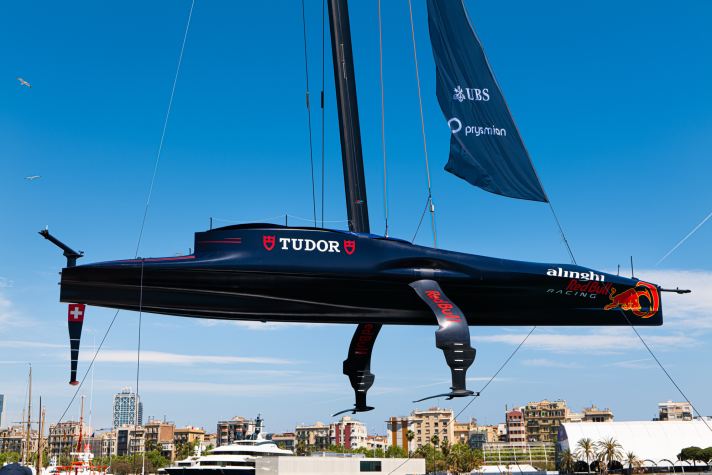
This in turn, in combination with the reduced number of crew, eliminated structure in the rear area and led to shortened capsule cockpits. The Swiss took this to the extreme and not only dropped the pods towards the stern early on, but also cut them radically. The "wings" pull slightly towards the centre of the ship to ensure that the flow around the hull is as turbulence-free as possible. Behind them, the stern is completely flat. The Swiss team, which wants to bring the silver jug back to the Alpine country after its historic victories in 2003 and 2007, was the first to unveil its racing car and immediately made an exclamation mark with its aggressive design. However, its performance to date does not justify this. "We assume that Alinghi's solution is not the best," commented Dr Martin Fischer on the competition's approach before the first meeting. So far, he seems to have been right. The Swiss only managed to reach the semi-finals of the LV Cup in the last possible place. The French were eliminated.
The German physicist and yacht designer Fischer has also designed a very special yacht with his British Cup Hunters. With its extremely deep and voluminous bustle (see below) and high cockpit freeboard, it initially looks very bulky, and the eye-catching paintwork does the rest. However, the new "Britannia" may actually be best suited to the conditions off Barcelona.
Bustle mould: important design decision for the America's Cup 2024
This is because the bulge on the underside of the hull, which is more pronounced on all AC75s of the new generation, has multiple uses. Firstly, the bustle is intended to support the end plate effect, i.e. to prevent pressure equalisation between leeward and windward in the best possible way. At the same time, its volume is intended to prevent strong diving and minimise braking. For this reason, it is very sharply cut in the lower area so that no great resistance is created when this part hits the water.
An important design decision had to be made here, which also explains the different characteristics. "There is a trade-off between resistance during take-off, i.e. when the hull is still in the water, and efficiency when the boat is flying," says Fischer. When the boat is in the air, you would prefer to have just a vertical plate that prevents pressure equalisation. That, in turn, is pretty bad for take-off. The British team seems to have focussed more on functionality in the waves of Barcelona than other syndicates. They, in turn, are likely to have prioritised aerodynamics.
High fashion found: Ineos Britannia's steep form curve
So far, the race has also been sailed on very light windy days with smooth water, which seemed to cause difficulties for the British Cupper, especially at the beginning of the elimination regatta. Both the final speed and the manoeuvrability were far below the standards of the other contenders. Towards the end of the series, the British managed to make up for this deficit, in particular through better communication on board and the resulting improved handling and presumably also adjustments to the boat and the hydrofoils.
They even went so far as to beat the initially dominant Italians several times and climb to the top of the table after the round robins. Helmsman Sir Ben Ainslie had repeatedly complained about the "lack of horsepower", especially during the last pre-regatta. However, the design team in the background seems to have met his demands; no other team has been able to show such a steep development curve so far.
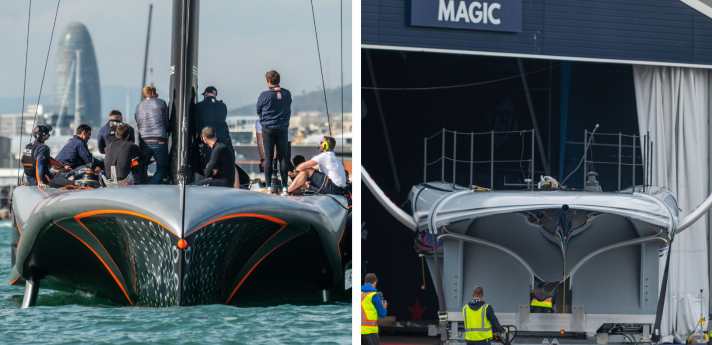
The extremely flat and minimalist counter-design from the Americans also revealed strengths and weaknesses in the first AC75 races before Barcelona. "There are different ways to get to the same or a similar destination," says Fischer. "I don't think the differences are dramatic." "Patriot 2.0" is characterised by the lowest resistance due to the smallest volume. To achieve this, the cyclists were even accommodated horizontally to lower the sidepods even further.
American Magic: On the wrong track with the recumbent bike?
The latter seems to have become their downfall in the meantime. This is because cycling in a lying position is far less efficient than pedalling in the regular upright position. Added to this is the presumably poorer ventilation of the cycling cockpits. The athletes are completely below deck and the opening to the top is partially closed by an aerodynamic cover.
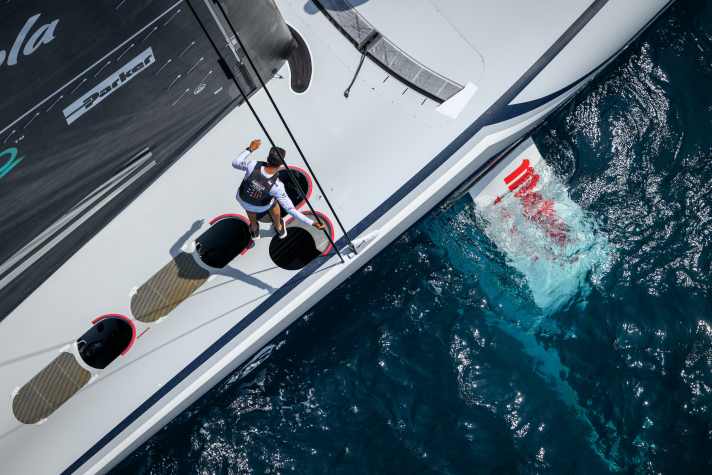
With the same number of cyclists (four) as all the other teams, American Magic should generate significantly less energy. However, this is crucial in changeable conditions and during manoeuvres, as all the trimming equipment depends on it. Only the adjustment of the foils is made possible by electric motors. In some races, this has already led to a certain restriction of manoeuvring freedom.
Meanwhile, Luna Rossa Prada Pirelli is in the semi-finals with the most visually extravagant cupper. The Italians, who lost the 2021 match with foil whisperer Fischer, work closest to the defenders with their lines. They also performed strongly right from the start and even managed to snatch a win from the New Zealanders. A return to the America's Cup match is therefore possible, but far from certain in view of recent results.
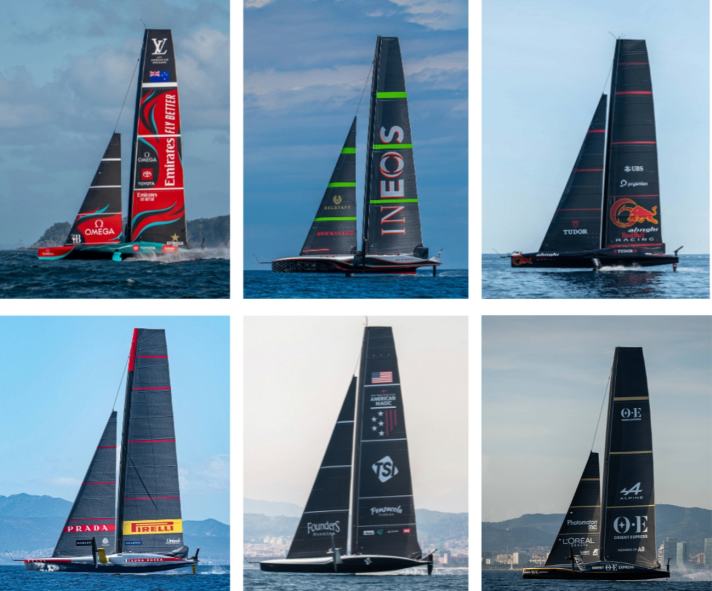
37th America's Cup: Can the New Zealanders still be stopped?
Defending champions Emirates Team New Zealand are waiting there. With "Taihoro", they have probably presented the most confident development of last year's winning yacht and brought it round the course in dominant fashion. However, they did not remain unbeaten. It is not clear from the outside whether this was due to actual weaknesses in the boat and crew or rather tests. The Kiwis sailed the Round Robins as defenders in a special role. The races in which they took part did not count towards any team's score.
The special role also means that the New Zealanders will withdraw from the semi-finals and will no longer be part of the Louis Vuitton Cup. This means that the team now has over a month before it has to return to the race track. A month in which they will undoubtedly use the knowledge they have now gained to make further adjustments, the most recent being a foil change.
At the same time, regatta practice is lacking in this final period. Ineos Britannia's improved performance during the LV Cup is just one indication of the enormous importance of this. Whether this will be enough for the challengers to prevent the historic first of three consecutive Cup victories for the New Zealanders remains to be seen from 12 October.

